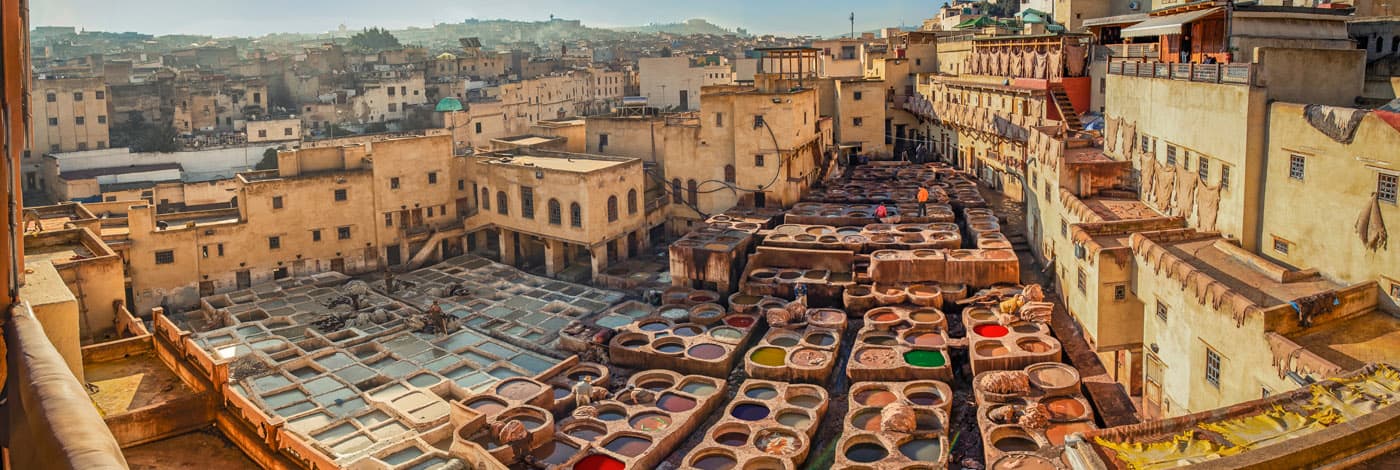
The Leather Tanneries of Fez
If you are interested in watching the ancient medieval tanning process and how it has barely changed through centuries, a visit to the Leather Tanneries of Fez comes on the top of your must-visit sights list. Among the three leather tanneries in Fez’s old quarter, the popular Chouara Tannery stands as the largest and most astonishingly photogenic one. Reputed to be the oldest tannery in the world, the Chouara with its dyeing vats is undoubtedly regarded as one of the most iconic sights in Fez.
Location & History:
Situated near the Saffarin Madrasa (the ancient school of the metalworkers) along the river in the ancient quarter of Fez Medina (known by the locals as Fes el-Bali), Chouara Tannery’s carefully chosen location near the river came in handy by providing the water supply required for the leather industry.
History:
As most of the historical sources and references state, the construction of Chouara Tannery dates back the foundation of the city of Fez itself during the Idrisid Dynasty by Idris II in the late 8th Century. Since its operation at least in the 11th Century and up till the moment, the Chouara tannery still reflects the medieval leather industry in Fez which started as early as the city’s foundation.
Structure:
Similar to other tanneries in Fez, Chouara Tannery, as showed in all the photos published online through travel blogs and tour reports, consists of several stone vessels and vats filled with different dyes spread out like a tray of watercolors. The view of workers kneading with their feet on the hides of animals like cows, camels and goats soaked in the dye-filled pools is considered the most remarkable view in Chouara Tannery.
How to visit Chouara Tannery :
Although the old medina of Fez is like a maze that makes the way to the Chouara Tannery even with the use of the GPS a bit confusing, you will never get lost with the smell of the dyes coming from the tannery pits (the smell is unpleasant, yet it is not as bad as you can imagine).
The best way to visit Chouara Tannery and to witness in action the techniques used by the leather tanners in the process of dyeing leather without any modern machinery like their medieval forbears is to walk through one of the leather shops with terraces surrounding the tannery. From these terraces at leather shops, you can easily look down onto the tannery pits. Don’t forget tipping the shopkeeper whose terrace you are using (around 10 Moroccan Dirhams), though it is officially free to see the tanneries from there.
The best vantage points for tannery observation are the roof top of shop No. 10 as well as shop No. 64. To reach one of these shops, just go north of the street metal sign of Derb Chouara, then turn right, heading downhill. You will find the shop on the second right.
What to see in Chouara Tannery:
The most spectacular show for Fez Tanneries’ visitors in general and Chouara ones in particular is to observe and learn the whole phases of manual leather tanning process by Moroccan tanners as inherited from their ancestors in ancient medieval times.
In Chouara Tannery the first phase of leather tanning is to soak the skins of cows, goats or camels for a couple of days in a mixture of water, salt, limestone, cow urine and pigeon poop. Such mixture which contains ammonia as poop and urine softens the skins whilst the salt and limestone remove the fat, flesh and hair on the hides.
Few days later, the hides get spotless by being washed and scratched before being placed into the dyeing vessels. All the dyes in tannery vats come from plants and the color is determined by the type of plant from which is extracted. For Example; orange comes from henna, blue from indigo, red, from poppy or paprika while yellow is mainly from saffron. However, pomegranate, or even a mix of turmeric and mimosa flowers come as alternatives for saffron which is relatively expensive.
Using their hands or even kneading with their bare feet on the hides in the pits, the tanners start dyeing the hides. Once the dyeing process is finished, they are taken out and hung up to dry in the sun.
Later on, the skillful Moroccan craftsmen turn the finished dyed leather into authentic leather products like the famous Moroccan slippers, known as Babouches, as well as wallets, handbags, furniture and other leather accessories.
Things to know before visiting Chouara Tannery:
- A pre-arranged guided tour is an option
Since getting to the Tanneries is a bit tricky and confusing, hiring a local guide or joining an excursion arranged by a travel agency seems to be the best way to visit Chouara Tannery.
- Viewing Chouara Tannery from one of the surrounding terraces
The most enjoyable way to view the tannery is through the terraces of leather shops. Some shopkeepers will claim that the only view of the tanneries will be available from their terraces and other will even tell you that their terraces have the best view. As mentioned earlier, viewing tanneries is available from all terraces and the best photographic opportunities will be available from shop No 10 and shop No 64.
- Tipping shopkeepers for using their terraces
Using the terraces of leather shops for viewing the tanneries is officially free; yet tipping the shopkeepers for using them would save you a lot of hassle. The tip amount is usually around 10-20 Moroccan Dirhams (Around 1-2 US dollars)
